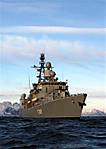‘We distant sons desire to stand in any peril beside the lion mother of our race, and to the utmost of our resources prove to her and to the world how dear to us is Britain’s name and greatness. We recognise that Britain’s acknowledged supremacy of the seas goes for the maintenance of peace, and that any weakness, either in the Homeland or abroad, makes what ought to be a dominant position a dangerous one. Sacrifices must be made to show competitive nations that, although separated by seas, we are in reality one for the preservation of our Empire’s greatness.’
So said New Zealand’s Prime Minister in 1909 announcing that NZ was offering the Motherland the free gift of a first class battleship. This proved enormously popular in NZ and the British acknowledged this by naming the ship after the country.
HMS New Zealand was one of three Indefatigable-class battlecruisers built for the defence of the British Empire. Launched in 1911, the ship was funded by the Government of New Zealand* as a gift to Britain, and she was commissioned into the Royal Navy in 1912. She had been intended for the China Station, but was released by the New Zealand Government at the request of the Admiralty for service in British waters.
During 1913, HMS New Zealand was sent on a ten-month tour of the British Dominions, with an emphasis on a visit to her namesake nation. She was back in British waters at the start of World War I, and operated as part of the Royal Navy's Grand Fleet, in opposition to the German High Seas Fleet. During the war, the battlecruiser participated in all three of the major North Sea battles—Heligoland Bight, Dogger Bank, and Jutland—and was involved in the response to the inconclusive Raid on Scarborough, and the Second Battle of Heligoland Bight. HMS New Zealand contributed to the destruction of two cruisers during her wartime service and was hit by enemy fire only once, sustaining no casualties; her status as a "lucky ship" was attributed by the crew to a Māori piupiu(warrior's skirt) and hei-tiki (pendant) worn by the captain during battle.
After the war, HMS New Zealand was sent on a second world tour, this time to allow Admiral John Jellicoe to review the naval defences of the Dominions. In 1920, the battlecruiser was placed in reserve. She was broken up for scrap in 1922 in order to meet Britain's tonnage limit in the disarmament provisions of the Washington Naval Treaty. (Wikipedia)
*The NZ Government borrowed £2 million to pay for the ship and didn’t finally pay it off until 1944, 22 years after it had been scrapped.
I thought I would do a build blog and a kit review as I go along.
The Kit
Well the box art is not up there with the more established kit producers with a just a simple sepia toned photo adorning the white lid of a top opening box.

The kit is well packed with the hull protected by bubble wrap and the resin pieces in zip lock bags within two smaller sturdy white boxes.
The detail for this kit is very fine and matches any of the new styrene kits available. All the pieces are undamaged with only two of the smaller pieces having come adrift of their casting stubs.
Combrig’s HMS New Zealand is available in either waterline or full hull and this is easily arranged as the hull is presented as top and bottom rather than two length way halves. The hulls are sharply cast though you will need to some patience to remove the casting stubs which run the full length of both hulls with saw and sander. Both hulls have substantial internal bracing as part of the casting and they feel very solid in the hand.



So that is my first piece of work to undertake. I will be back with more review as I progress.
cheers
Michael













































